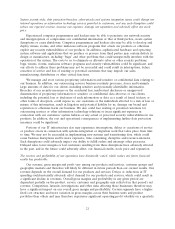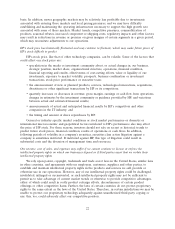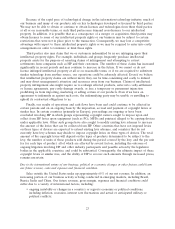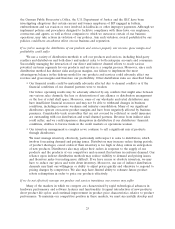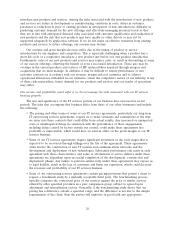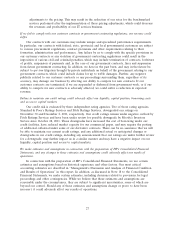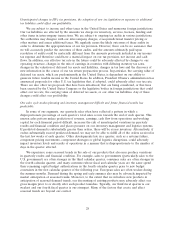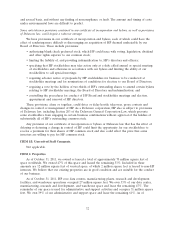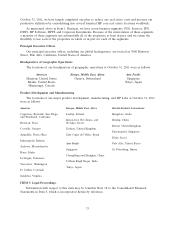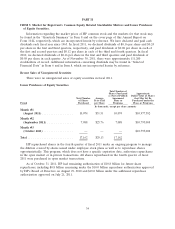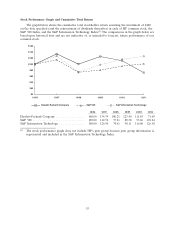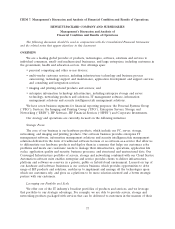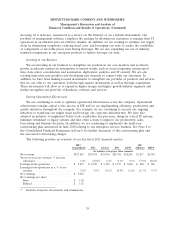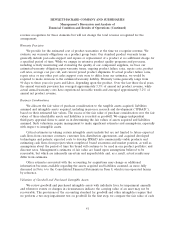HP 2011 Annual Report Download - page 39
Download and view the complete annual report
Please find page 39 of the 2011 HP annual report below. You can navigate through the pages in the report by either clicking on the pages listed below, or by using the keyword search tool below to find specific information within the annual report.• persuading employees that business cultures are compatible, maintaining employee morale and
retaining key employees, engaging with employee works councils representing an acquired
company’s non-U.S. employees, integrating employees into HP, correctly estimating employee
benefit costs and implementing restructuring programs;
• coordinating and combining administrative, manufacturing, research and development and other
operations, subsidiaries, facilities and relationships with third parties in accordance with local
laws and other obligations while maintaining adequate standards, controls and procedures;
• achieving savings from supply chain integration; and
• managing integration issues shortly after or pending the completion of other independent
transactions.
Managing business combination and investment transactions requires varying levels of management
resources, which may divert our attention from other business operations. These business combination
and investment transactions also have resulted, and in the future may result, in significant costs and
expenses and charges to earnings, including those related to severance pay, early retirement costs,
employee benefit costs, asset impairment charges, charges from the elimination of duplicative facilities
and contracts, in-process research and development charges, inventory adjustments, assumed litigation
and other liabilities, legal, accounting and financial advisory fees, and required payments to executive
officers and key employees under retention plans. Moreover, HP has incurred and will incur additional
depreciation and amortization expense over the useful lives of certain assets acquired in connection
with business combination and investment transactions, and, to the extent that the value of goodwill or
intangible assets with indefinite lives acquired in connection with a business combination and
investment transaction becomes impaired, we may be required to incur additional material charges
relating to the impairment of those assets. In order to complete an acquisition, we may issue common
stock, potentially creating dilution for existing stockholders. We may also borrow to finance
acquisitions, and the amount and terms of any potential future acquisition related or other borrowings,
as well as other factors, could affect our liquidity and financial condition. In addition, HP’s effective tax
rate on an ongoing basis is uncertain, and business combination and investment transactions could
adversely impact our effective tax rate. We also may experience risks relating to the challenges and
costs of closing a business combination and investment transaction and the risk that an announced
business combination and investment transaction may not close. As a result, any completed, pending or
future transactions may contribute to financial results that differ from the investment community’s
expectations in a given quarter.
Unforeseen environmental costs could impact our future net earnings.
We are subject to various federal, state, local and foreign laws and regulations concerning
environmental protection, including laws addressing the discharge of pollutants into the air and water,
the management and disposal of hazardous substances and wastes, the cleanup of contaminated sites,
the content of our products and the recycling, treatment and disposal of our products, including
batteries. In particular, we face increasing complexity in our product design and procurement
operations as we adjust to new and future requirements relating to the chemical and materials
composition of our products, their safe use, the energy consumption associated with those products,
climate change laws and regulations, and product take-back legislation. We could incur substantial
costs, our products could be restricted from entering certain jurisdictions, and we could face other
sanctions, if we were to violate or become liable under environmental laws or if our products become
non-compliant with environmental laws. Our potential exposure includes fines and civil or criminal
sanctions, third-party property damage, personal injury claims and clean up costs. Further, liability
under some environmental laws relating to contaminated sites can be imposed retroactively, on a joint
31


